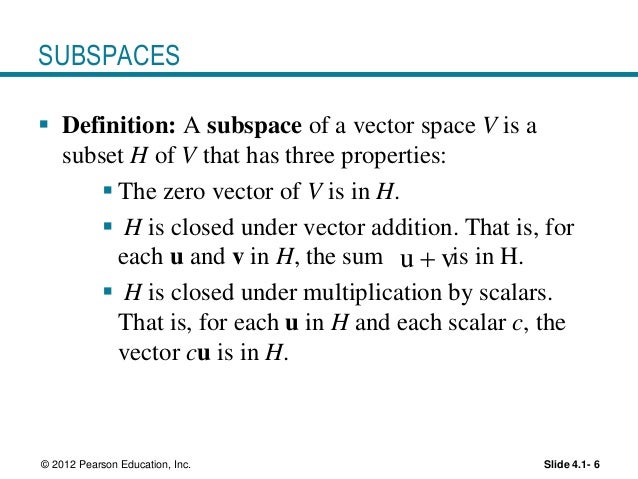
In the context of our Hilbert space, if for every sequence $(x_n)$ in $M$ with a limit $x\in\mathcal H$, we have $x\in M$, then $M$ is closed.Īs Michael Hardy pointed out, a subspace of a finite-dimensional vector space is always closed, so this distinction only need be made for infinite-dimensional Hilbert spaces. Therefore $M$ is a "closed subspace" if and only if $M$ is a subspace, and the complement of $M$ is open with respect to the metric topology.Īn equivalent definition for a set $M$ to be closed in a metric space is that if $(x_n)$ is a sequence of elements in $M$ that is convergent, then the limit is in $M$ (i.e. So every subspace is a vector space in its own right, but it is also defined. is a closed linear subspace of C (0, 1), and is a Banach space equipped with.

In a topological space, a closed set can be. A subspace is a vector space that is contained within another vector space. Definition 5.1 A Banach space is a normed linear space that is a complete.

If W is a subset of a vector space V and if W is itself a vector space under the inherited operations of addition and scalar multiplication from V, then W is called a subspace. The metric d : X × X R is just the function d. Subspaces - Examples with Solutions \( \) \( \) \( \) \( \) Definiiton of Subspaces. Then ( X, d ) is a metric space, which is said to be a subspace of ( M, d). We define a metric d on X by d ( x, y) d ( x, y) for x, y X. if $u,v\in W$ then $u+v\in W$ and if $c$ is a scalar then $cv\in W$) - and Hilbert spaces are vector spaces. In geometry, topology, and related branches of mathematics, a closed set is a set whose complement is an open set. The subset with that inherited metric is called a 'subspace.' Definition 2.1: Let ( M, d) be a metric space, and let X be a subset of M. Recall that if $V$ is a vector space and $W\subset V$, then $W$ is a subspace if and only if $W$ contains the zero vector and is closed under addition and scalar multiplication (i.e. suppose the $n$th member of a basis of $\ell^2$ is A subset of a topological space is termed sequentially closed if given any convergent sequence of points in the subset(viz, a sequence of points.

typical to require subspaces to be closed and define the open subspaces to be. In infinite-dimensional spaces, the space of all finite linear combinations of the members of an infinite linearly independent set is not closed because it fails to contain infinite linear combinations of is members. definitions and theorems from finite dimensional linear algebra and real. A subset A of a topological space X is said to be closed if the set X A is open. In finite-dimensional Hilbert spaces, all subspaces are closed. It is a subspace that is closed in the sense in which the word "closed" is usually used in talking about closed subsets of metric spaces. as kernels (Theorem 2.6), and in particular E has a closed linear subspace that cannot be realised as the kernel of a bounded linear operator on E.


 0 kommentar(er)
0 kommentar(er)
